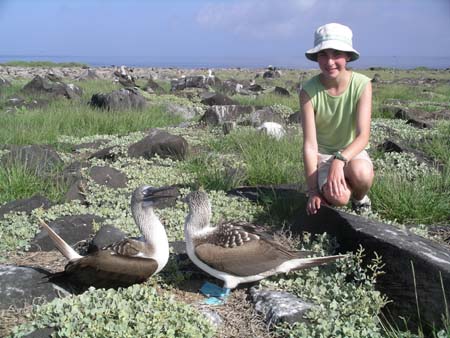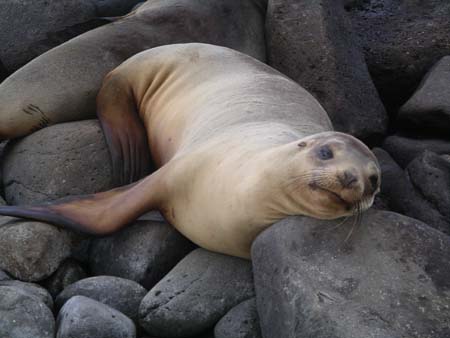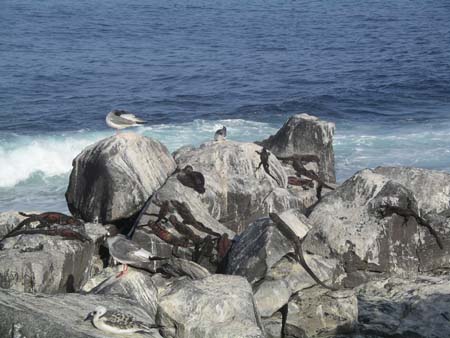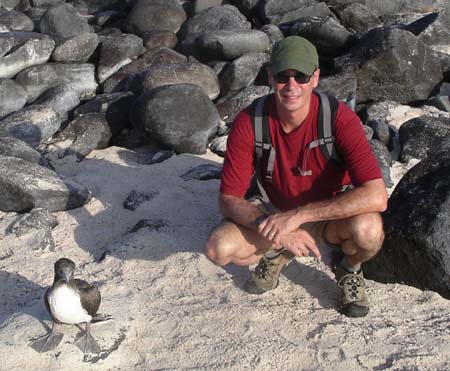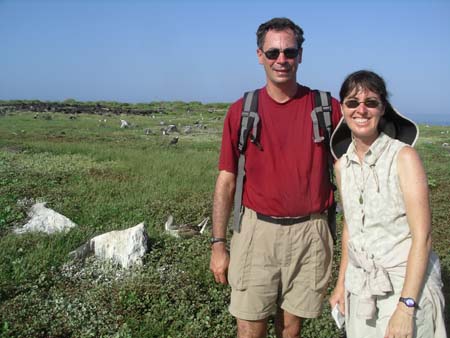Thursday, April 22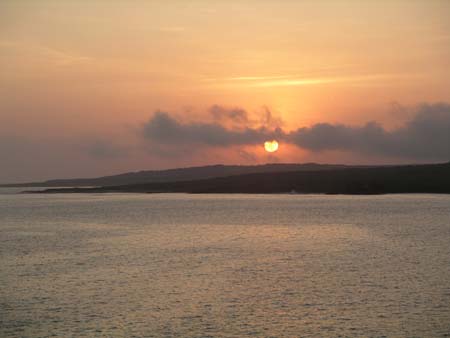
Paula and Steve: We woke early this morning to a great sunrise (after a 6:00AM wakeup call broadcast throughout the entire ship!), had breakfast and quickly boarded our zodiac in anticipation of our first opportunity to see the wonderful wildlife of the Galapagos Islands. We were not disappointed…
The sky was clear and the air hot and humid even though it was only 8:00AM.
As we approached Espanola Island, the oldest of all the Galapagos Islands,
we were greeted by groups of playful sea lions that swam out to greet us.
We stepped ashore, and immediately began to experience the amazing tameness
of 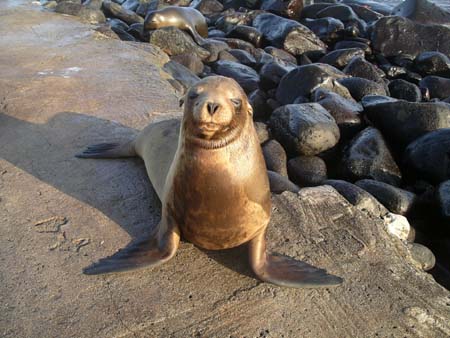 the
Galapagos wildlife that we have heard and read so much about. The path leading
from the small dock to the beach where we began our hike was lined with sea
lions, and marine iguanas, many of which we literally needed to step over
and around in
the
Galapagos wildlife that we have heard and read so much about. The path leading
from the small dock to the beach where we began our hike was lined with sea
lions, and marine iguanas, many of which we literally needed to step over
and around in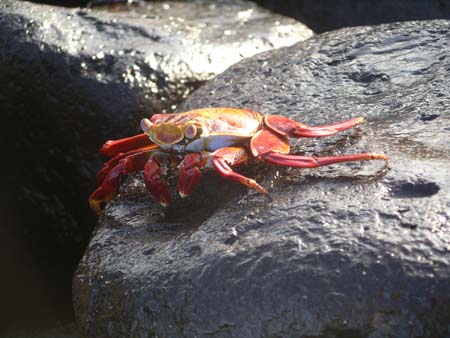 order to get by! At one point, we encountered a sea lion who was nursing her
pup right on the dock, and the naturalist had to clap loudly just to get her
to move. The abundance of the wildlife also amazed us - the sea lions, iguanas
and bright red crabs (called "Sally Lightfoot Crabs")
order to get by! At one point, we encountered a sea lion who was nursing her
pup right on the dock, and the naturalist had to clap loudly just to get her
to move. The abundance of the wildlife also amazed us - the sea lions, iguanas
and bright red crabs (called "Sally Lightfoot Crabs") 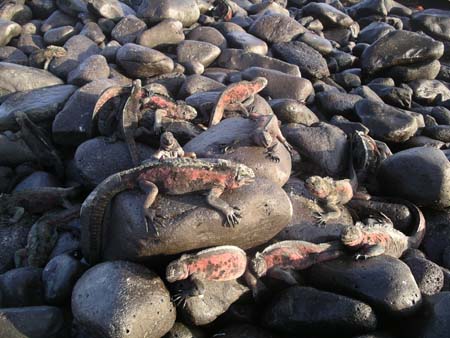 were
everywhere! All the movies, pictures and books that we had seen and read in
advance of our arrival here couldn't prepare us for the thrill we felt as
we first stepped ashore.
were
everywhere! All the movies, pictures and books that we had seen and read in
advance of our arrival here couldn't prepare us for the thrill we felt as
we first stepped ashore.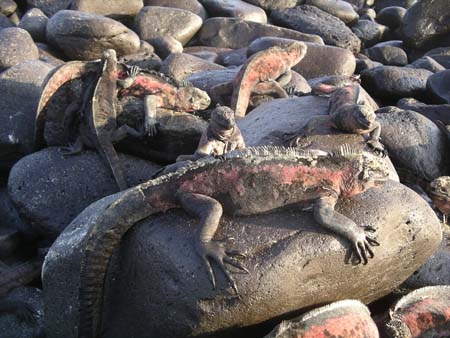
The wildlife on the Galapagos Islands has evolved over millions of years without human contact, and many of the birds and animals here have no natural predators. We were told by our naturalist during yesterday's briefing that we would be able to get very close to all the wildlife. However, to avoid impacting their behavior, it's important not to have direct contact with these creatures. We had to keep reminding ourselves today that these birds and animals are all wild - they are so tame and unafraid that they almost look like pets.
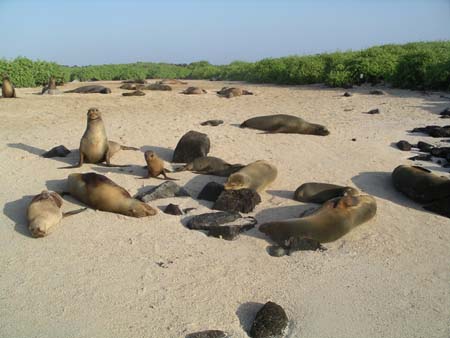 Our
first stopping point was on a beach filled with colonies of Galapagos Sea
Lions (one of two varieties here). We have seen many sea lions before but
never so closely. Though many lay sleeping on the rocks and sand, others wobbled
up the path as if to welcome us to their home. We saw bull sea lions (the
males) carefully protecting their territory and their harems. We watched hundreds
of females, many nursing their pups (we were close enough to even hear the
sucking noises). We learned that the pups will nurse for three whole years
before they go out of their own. The pups are especially fun to watch as they
playfully jump and roll in the water. We also discovered that the colors of
these Galapagos Sea Lions change to camouflage them - they are black in the
water to resemble rocks an
Our
first stopping point was on a beach filled with colonies of Galapagos Sea
Lions (one of two varieties here). We have seen many sea lions before but
never so closely. Though many lay sleeping on the rocks and sand, others wobbled
up the path as if to welcome us to their home. We saw bull sea lions (the
males) carefully protecting their territory and their harems. We watched hundreds
of females, many nursing their pups (we were close enough to even hear the
sucking noises). We learned that the pups will nurse for three whole years
before they go out of their own. The pups are especially fun to watch as they
playfully jump and roll in the water. We also discovered that the colors of
these Galapagos Sea Lions change to camouflage them - they are black in the
water to resemble rocks an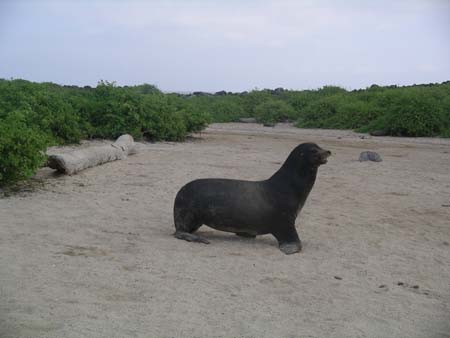 d
turn golden like the sand while sitting on the beach.
d
turn golden like the sand while sitting on the beach.
We were warned to keep our distance from the bulls, but one member of our
group got a little close with his camera and attracted the attention of a
particularly large sea lion that m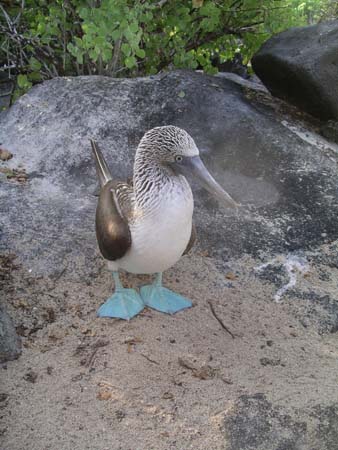 ade
it very clear who owned the beach. After repeated warnings from the naturalist,
the lucky photographer backed off just in time…
ade
it very clear who owned the beach. After repeated warnings from the naturalist,
the lucky photographer backed off just in time…
From the beach we began walking on a trail that hugs the shore of Espanola
Island. We quickly fell in love with the Blue-footed boobies. Hundreds cover
this small island and most are in pairs as the mating season is in full swing.
We watched as males and females opened their wings and danced with their blue
webbed feet to attract one another. Our 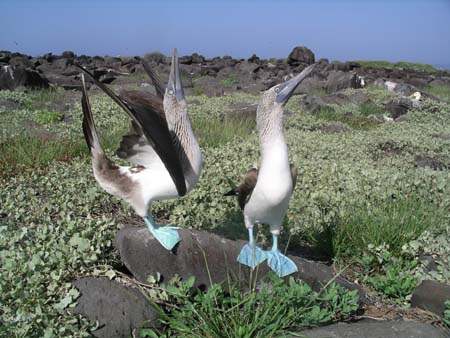 appreciation
of their colors, sounds and behaviors was deepened by these close encounters.
We couldn't stop taking pictures. Our guide explained that it is easy to differentiate
the males from females by looking at the size of their pupils and listening
to their calls. The island was filled with their sounds - the male with his
high pitched whistle and the female with her deep honk.
appreciation
of their colors, sounds and behaviors was deepened by these close encounters.
We couldn't stop taking pictures. Our guide explained that it is easy to differentiate
the males from females by looking at the size of their pupils and listening
to their calls. The island was filled with their sounds - the male with his
high pitched whistle and the female with her deep honk.
At one point we walked through a wide open nesting area that was filled with the boobies (a funny word to keep writing here!), many of which were sitting or standing right on the trail. We thought back to walks we've taken on Cape Cod through nesting areas used by gulls, and how these birds squawked and "dive bombed" us as we tried to pass. Here, the tame boobies simply looked at us with curiosity, seeming to want to welcome us to their unique home.
Here are some of our best blue-footed booby pictures...
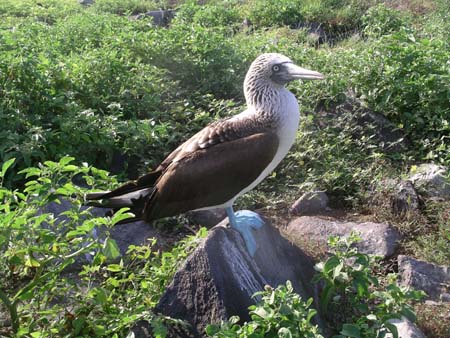

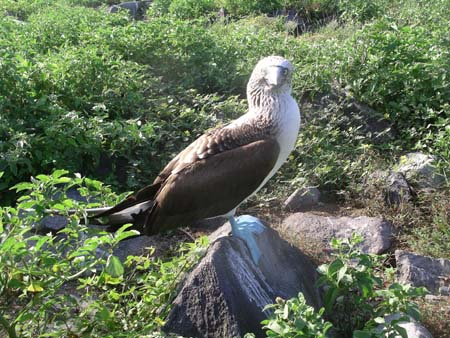
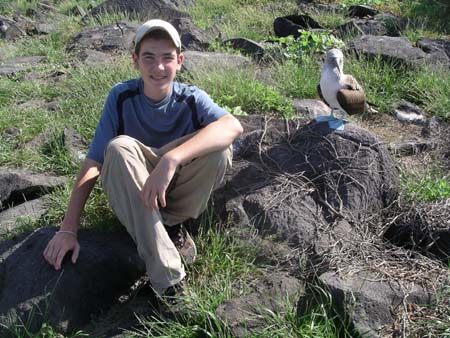
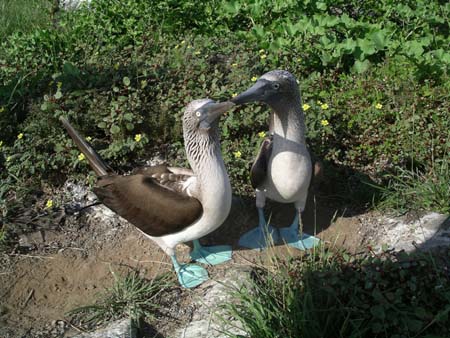
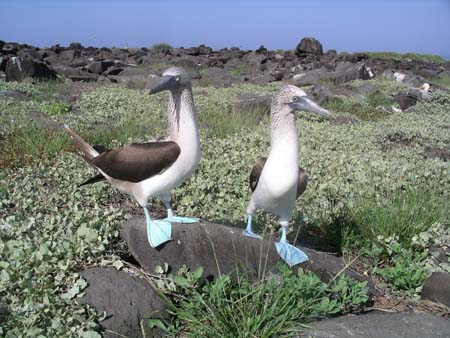
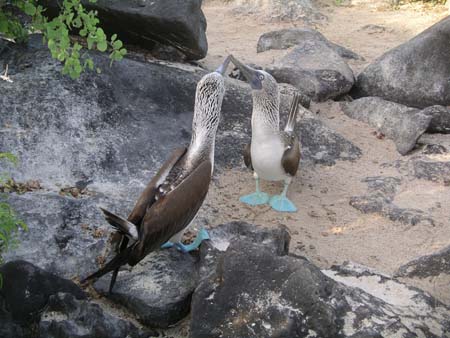
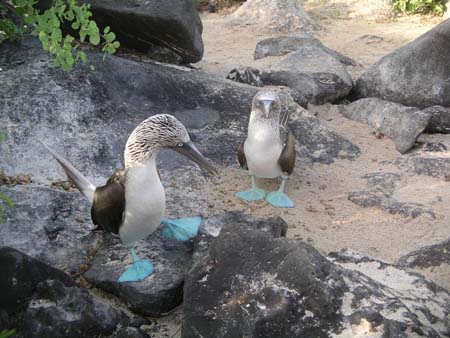
In this hese two pictures just above, the boobies are doing their famous mating dance.
These are pictues of juveniles, before they get their beautiful blue feet...
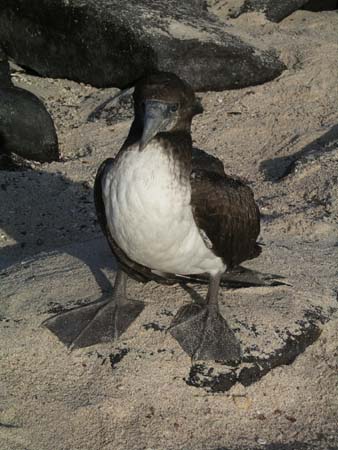
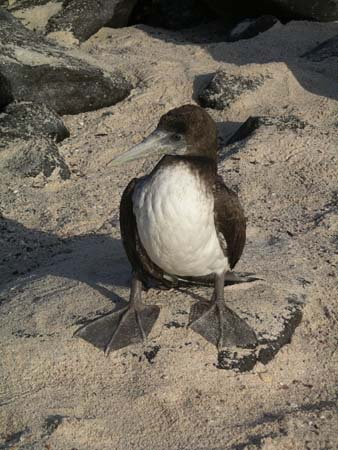
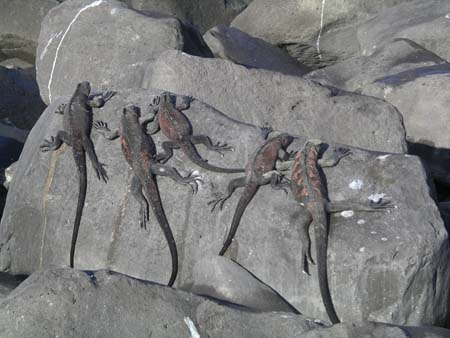
We also had close encounters with hundreds of marine iguanas. These are the
only iguanas in the world capable of swimming in the ocean. Over time they
have adapted desalinization glands in their heads that allow them to eat the
vegetation in the ocean. Our  naturalist
explained that they like to sit on the rocks to absorb the sun. This heats
up their body so that they can tolerate the cooler waters. While the males
were mostly black with bits of red, the females have beautiful red, blue and
green coloring to attract mates.
naturalist
explained that they like to sit on the rocks to absorb the sun. This heats
up their body so that they can tolerate the cooler waters. While the males
were mostly black with bits of red, the females have beautiful red, blue and
green coloring to attract mates.
There were so many of these iguanas that we had to be extremely careful not
to step on them as we walked. They appear everywhere on rocks, beaches 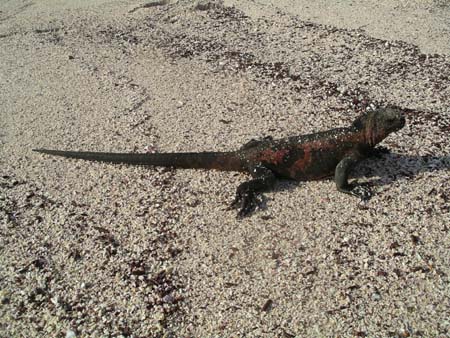 and
even in the middle of the trails. The iguanas of Espanola Island are the most
colorful of all the iguanas in the Galapagos Islands, and it was great to
see them in such abundance today.
and
even in the middle of the trails. The iguanas of Espanola Island are the most
colorful of all the iguanas in the Galapagos Islands, and it was great to
see them in such abundance today.
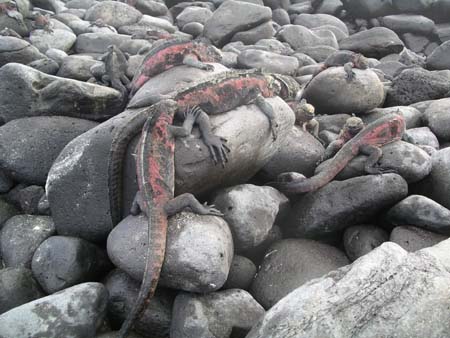
These two pictures of a female with beautiful blue coloring used to attract a mate.
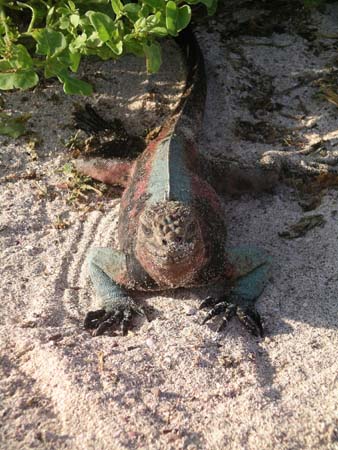
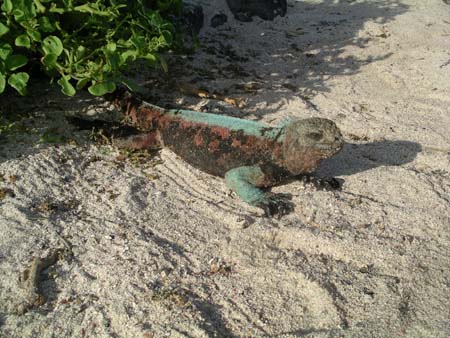
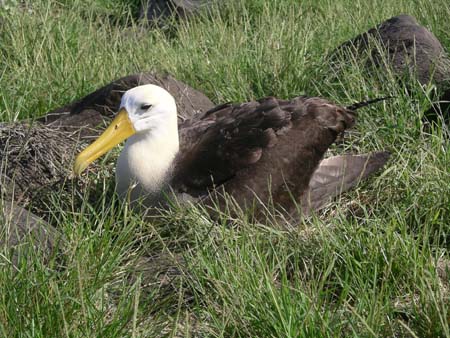
In April, the albatross migrate back to the islands to mate, and we were
fortunate to 5-6 pairs on the island. Though smaller, these albatross appear
similar to the ones we saw in New Zealand. They mate for life and take turns
sitting on their eggs. They sat today among 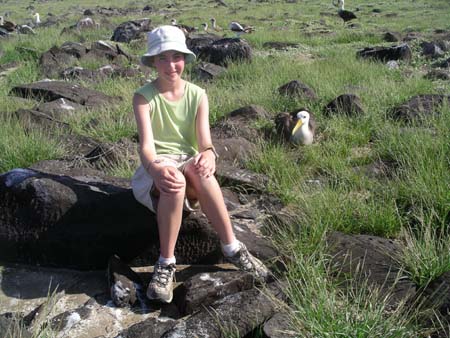 the
blue-footed boobies and were not at all bothered by our visit. In fact, one
of the most interesting aspects of the wildlife here is the presence of many
different animals all sharing the same habitat. We literally saw birds, sea
lions and iguanas all on the same rock.
the
blue-footed boobies and were not at all bothered by our visit. In fact, one
of the most interesting aspects of the wildlife here is the presence of many
different animals all sharing the same habitat. We literally saw birds, sea
lions and iguanas all on the same rock.
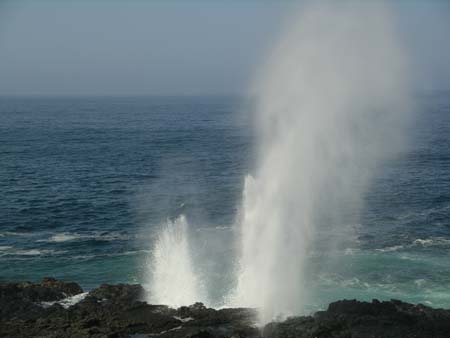
Our visit here was capped off by a large blow hole on the island. From a distance, we watched the ocean waves slam into a cliff, shooting water up to a height of 30-40 meters. Despite the heat, no one was anxious to return to the comfort of the ship - we all lingered as long as possible trying to take in the amazing site and wildlife on this beautiful island.
Each day's schedule on the boat involves an early-morning excursion, followed by lunch and time for relaxation on board before an afternoon outing that goes from 3:00-6:00. After our busy morning, we were thankful for the opportunity to rest and enjoy the boat for a few hours, and were refreshed as we arrived this afternoon at Santa Cruz Island. This is the home of Darwin Station, a center for the breeding and rearing of Galapagos tortoises. Here we got our first glimpse of these huge creatures, which was very exciting despite the fact that these particular animals are not in the wild (we are told that we'll have an opportunity to see them in the wild later during the week).
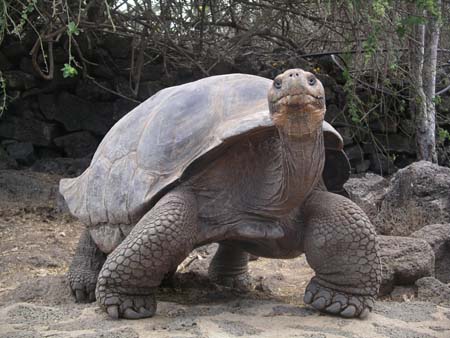 The
Galapagos tortoises can live to be 150 years old, and we saw several large
ones (up to 550 pounds!) that are estimated to all be over 100. The word "Galapagos"
actually comes from the Spanish word for "saddle", and thus the
islands are named after these amazing tortoises. At one time the population
of Galapagos tortoises exceeded 250,000, but well over 90% were killed for
their meat during the 19th and 20th centuries and only 15,000 survive today.
The
Galapagos tortoises can live to be 150 years old, and we saw several large
ones (up to 550 pounds!) that are estimated to all be over 100. The word "Galapagos"
actually comes from the Spanish word for "saddle", and thus the
islands are named after these amazing tortoises. At one time the population
of Galapagos tortoises exceeded 250,000, but well over 90% were killed for
their meat during the 19th and 20th centuries and only 15,000 survive today.
Of the 14 subspecies of Galapagos tortoises (all evolving from a common ancestor),
three are now extinct. A fourth subspecies, from Pinta Island, is represented
by only one surviving male - the famou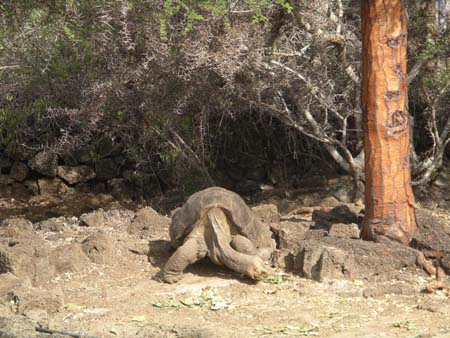 s
"Lonesome George" (pictured here on the right). Despite multiple
attempts, scientists have not been able to get George to breed with females
from the species that's genetically closest to George's. We were fortunate
to see Lonesome George out today enjoying a meal. We guessed that this may
be the only situation in the world where an entire species has been reduced
to a single captive animal.
s
"Lonesome George" (pictured here on the right). Despite multiple
attempts, scientists have not been able to get George to breed with females
from the species that's genetically closest to George's. We were fortunate
to see Lonesome George out today enjoying a meal. We guessed that this may
be the only situation in the world where an entire species has been reduced
to a single captive animal.
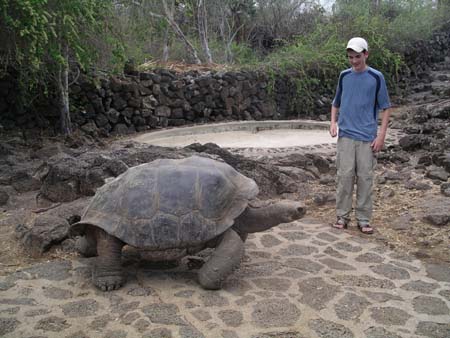

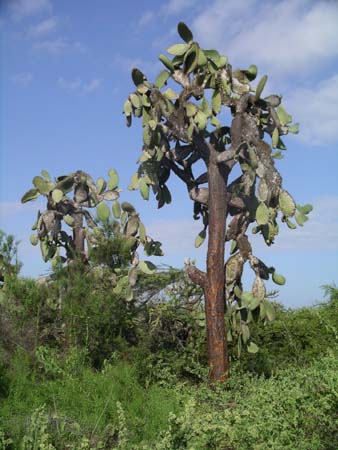
After visiting the Darwin Center, we had time to stroll through Puerto Ayora, the largest town on Santa Cruz Island. We did some shopping (mostly blue-footed booby items!) and took advantage of the opportunity to check e-mail before boarding our dinghy back to the ship.
We all agreed that this was a wonderful day, and are now eager for more. Tomorrow we'll be visiting Genovesa Island, where we should be able to see mating frigate birds with their distinctive red pouches, along with red footed boobies. In the afternoon, we'll have our first opportunity to snorkel, which should be great.
